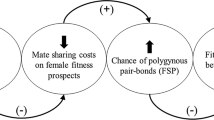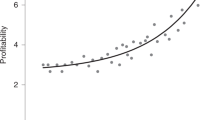Abstract
The polygyny threshold model predicts that a female chooses an already-mated male if the direct benefits of higher territorial quality compensate for the cost of mate sharing. The sexy son hypothesis (SSH) expands this framework from direct to indirect benefits assuming that polygynously-mated females give birth to sexy and subsequently polygynous sons. Although the SSH has generated much debate, empirical evidence is inconclusive. I argue that lack of support could be related to the SSH formulation of the polygyny threshold as a population-level mechanism making the female choice of a polygynous male either advantageous or disadvantageous regardless of any other difference between potential mates. Using a simulation approach, I show that individual variation in males’ quality should be considered because, otherwise, the empirical validation of the hypothesis is hampered, giving rise to patterns that are apparently irreconcilable with the SSH predictions.


Similar content being viewed by others
References
Alatalo RV, Carlson A, Lundberg A, Ulfstrand S (1981) The conflict between male polygamy and female monogamy: the case of the pied flycatcher Ficedula hypoleuca. Am Nat 117:738–753
Andersson MB (1994) Sexual selection. Princeton University Press, Princeton
Catchpole C, Leisler B, Winkler H (1985) Polygyny in the great reed warbler, Acrocephalus arundinaceus: a possible case of deception. Behav Ecol Sociobiol 16:285–291
Clutton-Brock T, Sheldon BC (2010) Individuals and populations: the role of long-term, individual-based studies of animals in ecology and evolutionary biology. Trends Ecol Evol 25:562–573
Davies NB (1989) Sexual conflict and the polygamy threshold. Anim Behav 38:226–234
Dietz JM, Baker AJ (1993) Polygyny and female reproductive success in golden lion tamarins, Leontopithecus rosalia. Anim Behav 46(6):1067–1078
Dorsey B, Olsson M, Rew LJ (2015) Ecological effects of railways on wildlife. In: van der Ree R, Smith DJ, Grilo C (eds) Handbook of road ecology. Wiley, Hoboken, pp 219–227
Dyrcz A (1986) Factors affecting facultative polygyny and breeding results in the Great Reed Warbler (Acrocephalus arundinaceus). J Ornithol 127:447–461
Emlen ST, Oring LW (1977) Ecology, sexual selection, and the evolution of mating systems. Science 197:215–223
Forstmeier W, Kuijper DPJ, Leisler B (2001) Polygyny in the dusky warbler, Phylloscopus fuscatus: the importance of female qualities. Anim Behav 62:1097–1108
Garcia-Gonzalez F, Simmons LW (2010) Male-induced costs of mating for females compensated by offspring viability benefits in an insect. J Evol Biol 23:2066–2075
Grønstøl GB, Byrkjedal I, Fiksen Ø (2003) Predicting polygynous settlement while incorporating varying female competitive strength. Behav Ecol 14:257–267
Grønstøl GB, Blomqvist D, Pauliny A, Wagner RH (2015) Kin selection and polygyny: Can relatedness lower the polygyny threshold? R Soc Open Sci 2:140409
Gustafsson L, Qvarnström A (2006) A test of the “sexy son” hypothesis: sons of polygynous collared flycatchers do not inherit their fathers’ mating status. Am Nat 167:297–302
Hansson B, Bensch S, Hasselquist D (2000) Patterns of nest predation contribute to polygyny in the great reed warbler. Ecology 81:319–328
Head ML, Hunt J, Jennions MD, Brooks R (2005) The indirect benefits of mating with attractive males outweigh the direct costs. PLoS Biol 3:0289–0294
Heisler IL (1981) Offspring quality and the polygyny threshold: a new model for the “sexy son” hypothesis. Am Nat 117:316–328
Huk T, Winkel W (2006) Polygyny and its fitness consequences for primary and secondary female pied flycatchers. Proc R Soc B Biol Sci 273:1681–1688
Huk T, Winkel W (2008) Testing the sexy son hypothesis: a research framework for empirical approaches. Behav Ecol 19:456–461
Jungwirth A, Johnstone RA (2019) Multiple evolutionary routes to monogamy: modeling the coevolution of mating decisions and parental investment. Am Nat 193(2):E29–E40
Kirkpatrick M (1985) Evolution of female choice and male parental investment in polygynous species: the demise of the “Sexy Son”. Am Nat 125:788–810
Kokko H, Booksmythe I, Jennions MD (2015) Mate-sampling costs and sexy sons. J Evol Biol 28:259–266
Mulder MB (1990) Kipsigis women’s preferences for wealthy men: evidence for female choice in mammals? Behav Ecol Sociobiol 27:255–264
Orians GH (1969) On the evolution of mating systems in birds and mammals. Am Nat 103:589–603
Pinxten R, Eens M (1990) Polygyny in the European starling: effect on female reproductive success. Anim Behav 40:1035–1047
Pomiankowski A, Iwasa Y, Nee S (1991) The evolution of costly mate preferences I, fisher and biased mutation. Evolution 45:1431–1442
Pribil S, Searcy WA (2001) Experimental confirmation of the polygyny threshold model for red-winged blackbirds. Proc Biol Sci R Soc 268:1643–1646
Qvarnström A, Sheldon BC, Pärt T, Gustafsson L (2003) Male ornamentation, timing of breeding, and cost of polygyny in the collared flycatcher. Behav Ecol 14(1):68–73
R Core Team (2019) R: a language and environment for statistical computing. Vienna, Austria
Searcy WA, Yasukawa K (1981) Does the “Sexy Son” hypothesis apply to mate choice in red-winged blackbirds? Am Nat 117:343–348
Searcy WA, Yasukawa K (1989) Alternative models of territorial polygyny in birds. Am Nat 134:323–343
Slagsvold T, Dale S (1994) Why do female pied flycatchers mate with already mated males: Deception or restricted mate sampling? Behav Ecol Sociobiol 34:239–250
Slagsvold T, Drevon T (1999) Female pied flycatchers trade between male quality and mating status in mate choice. Proc R Soc B Biol Sci 266:917–921
Stenmark G, Slagsvold T, Lifjeld JT (1988) Polygyny in the pied flycatcher, Ficedula hypoleuca: a test of the deception hypothesis. Anim Behav 36:1646–1657
Verner J (1964) Evolution of polygamy in the long-billed marsh wren. Evolution 18:9
Wagner RH (1994) Mixed mating strategies by females weaken the sexy son hypothesis. Anim Behav 47:1207–1209
Weatherhead PJ (1994) Mixed mating strategies by females may strengthen the sexy hypothesis. Anim Behav 47:1210–1211
Weatherhead PJ, Robertson RJ (1979) Offspring quality and the polygyny threshold: “the sexy son hypothesis”. Am Nat 113:201–208
Weatherhead PJ, Robertson RJ (1981) In defense of the “Sexy Son” hypothesis. Am Nat 113:201–208
Wittenberger JF (1981) Male quality and polygyny: the “ Sexy Son “ hypothesis revisited. Am Nat 117:329–342
Zabel CJ, Taggart SJ (1989) Shift in red fox, Vulpes vulpes, mating system associated with El Nino in the Bering Sea. Anim Behav 38:830–838
Acknowledgements
I am very grateful to a few fellow colleagues who have contributed to improving different aspects of this work. Among them, I would like to thank F. García-González, P. Edelaar, J. Potti, and A. Green and, for a revision of an early draft, Z. Tablado, A. Centeno-Cuadros, L. Campioni and M. D’Amico. In addition, I am grateful for the constructive reviews made by anonymous reviewers and A. Jungwirth. The author declares no conflict of interest.
Author information
Authors and Affiliations
Corresponding author
Additional information
Publisher's Note
Springer Nature remains neutral with regard to jurisdictional claims in published maps and institutional affiliations.
Electronic supplementary material
Below is the link to the electronic supplementary material.
Rights and permissions
About this article
Cite this article
Santoro, S. The neglected role of individual variation in the sexy son hypothesis. Evol Ecol 34, 1–9 (2020). https://doi.org/10.1007/s10682-019-10019-y
Received:
Accepted:
Published:
Issue Date:
DOI: https://doi.org/10.1007/s10682-019-10019-y




